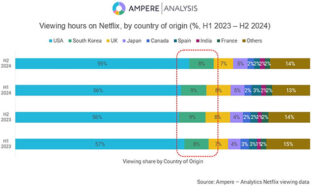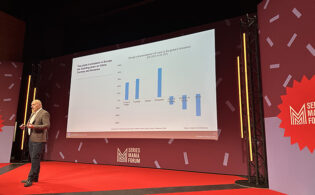Ampere Analysis data from Europe and North America finds that rather than shedding their pay-TV services, consumers are “doubling up” with subscriptions to pay TV, VOD and SVOD platforms.
Viewers are building their own TV bundles from all the options available, Ampere found, based on a survey of 53,000 internet users in Europe and North America. At the end of Q1 2017, 40 percent of respondents had built a custom TV bundle, up from 24 percent in mid-2015. The proportion of consumers taking just pay TV fell to 30 percent at the start of this year from 49 percent in Q3 2015. Meanwhile, the proportion with just on-demand services was 13 percent, up from 5 percent in 2015. “Many of these homes are supplementing a basic free terrestrial TV offer with SVOD,” Ampere said. “Some are replacing broadcast TV entirely.”
Ampere’s report continues, “Despite the explosion in television viewing options, the proportion of homes taking just pay TV, or it in combination with an SVOD service, has remained roughly stable at approximately 70 percent of respondents during the same timeframe.”
Richard Broughton, research director at Ampere Analysis, noted, “The often-predicted mass cord-cutting from pay TV, driven by the growth of SVOD, has yet to arrive. But let’s not get complacent. There are warning signs. Our research has found that consumers who are doubling-up on their TV services, combining their pay-TV service with one or more SVOD services, are twice as likely to be strongly considering leaving their main TV provider in the next six months. Pay-TV operators must match the ‘watch everywhere’ features of SVOD, and continue to invest in exclusive content if they are to avoid being left behind by more flexible competitors.”
In North America, the average spend on subscription television (pay TV and SVOD) for 12 months in 2016 was $311, reflecting an increase of $30 per person per year from five years ago. In Western Europe, the average consumer spends $95 per year on subscription television after sales tax, up from $78 five years ago. Households with access to subscription on-demand in Europe and North America are now typically taking between two and three SVOD services each. Netflix and Amazon have been the key drivers. Content exclusivity is the prime reason behind doubling up—94 percent of titles are exclusive to a single service.
“We estimate that subscription TV services have generated $18 billion of entirely new revenue over the last two years across the globe,” said Broughton. “Almost half (45 percent) of this new revenue was driven by SVOD services, the remainder by traditional cable and satellite companies. While a degree of cannibalization of subscription TV services is undoubtedly occurring as some consumers decide to cut the pay-TV cord, the general trend is for more, not less, access to television services. That suggests broadly positive outcomes for content owners and distributors, who can expect greater levels of spending on good quality television content.”






